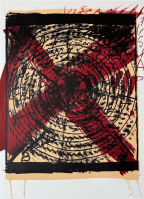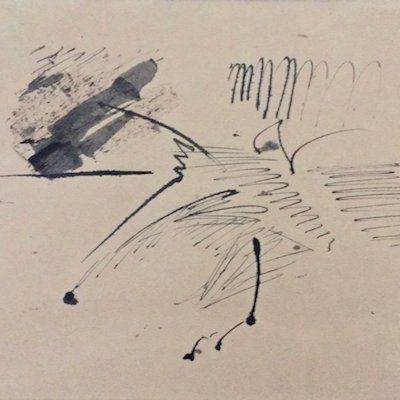
Details
Artist
Styles
// Antoni Tàpies' Esperit Catalá II is a powerful etching from 1974 that embodies the artist's characteristic use of symbols, texture, and abstraction. This piece, layered with complex iconography including keys, crosses, letters, and numbers, reflects Tàpies' exploration of Catalan identity and spirituality. The chaotic arrangement of white marks on a dark background suggests a chalkboard covered with cryptic inscriptions, invoking a sense of mystery and introspection. The heavy textures and raw lines lend a tactile quality, creating depth and inviting viewers to contemplate the cultural and historical layers embedded in Tàpies' work. His approach combines abstract expressionism with deeply personal and political themes, making Esperit Catalá II both a visual and intellectual exploration.
Esperit Catalá II, 1974
form
Medium
Size
56 x 76 cm
- Inches
- Centimeters
Edition
Price
- USD
- EUR
- GBP
Details
Artist
Styles
// Antoni Tàpies' Esperit Catalá II is a powerful etching from 1974 that embodies the artist's characteristic use of symbols, texture, and abstraction. This piece, layered with complex iconography including keys, crosses, letters, and numbers, reflects Tàpies' exploration of Catalan identity and spirituality. The chaotic arrangement of white marks on a dark background suggests a chalkboard covered with cryptic inscriptions, invoking a sense of mystery and introspection. The heavy textures and raw lines lend a tactile quality, creating depth and inviting viewers to contemplate the cultural and historical layers embedded in Tàpies' work. His approach combines abstract expressionism with deeply personal and political themes, making Esperit Catalá II both a visual and intellectual exploration.
- Recently Added
- Price (low-high )
- Price (high-low )
- Year (low-high )
- Year (high-low )
Antoni Tapies
Primer Congreso Nacional De Neuropedriatria, 1982
Limited Edition Print
Etching
EUR 1,875
What is Art Informel?
Art Informel is a French term referring to the gestural and improvisational techniques common in abstract painting during the 1940s and 50s. It encompasses various styles that dominated these decades, characterized by informal, spontaneous methods. Artists used this term to describe approaches that moved away from traditional structures and embraced more expressive, unstructured techniques.

























































































































